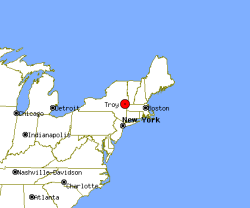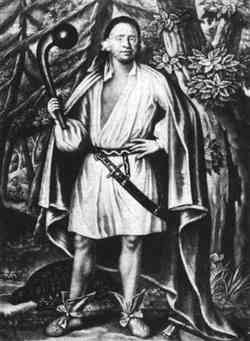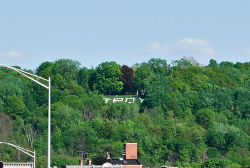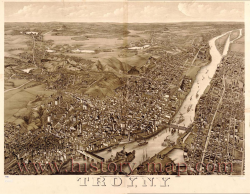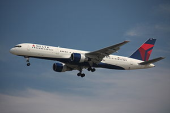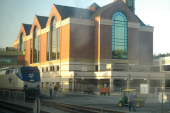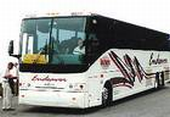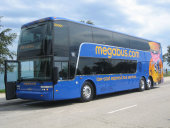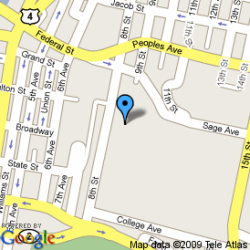
|

|
Conference Location
|
Troy's motto is Ilium fuit, Troja est, which means "Ilium was, Troy is". |
History |
Prior to the arrival of Europeans, the Mohican Indians had a number of settlements along the Hudson River near the confluence with the Mohawk River. The land comprising the Poesten Kill and Wynants Kill areas were owned by two Mohican groups. The land around the Poesten Kill was owned by Skiwias and was called Panhooseck. The area around the Wynants Kill, was known as Paanpack, was owned by Peyhaunet. The land between the creeks, which makes up most of downtown and South Troy, was owned by Annape. South of the Wynants Kill and into present-day North Greenbush, the land was owned by Pachquolapiet. These parcels of land were sold to the Dutch between 1630 and 1657 and each purchase was overseen and signed by Skiwias, the sachem at the time. The Dutch began settling in the mid 17th century; the patroon Kiliaen van Rensselaer called the area Pafraets Dael, after his mother. The site of the city was a part of the Rensselaerswyck, a patroonship created by Kiliaen van Rensselaer. Control of New York passed to the English in 1664 and in 1707 Derick Van der Heyden purchased a farm near today's downtown area. In 1771 Abraham Lansing had his farm in today's Lansingburgh laid out into lots. Responding to Lansing's success to the north, in 1787, Van der Heyden's grandson Jacob had his extensive holdings surveyed and laid out into lots as well, calling the new village Vanderheyden. |
|
In the post-Revolutionary War years, as central New York was first settled, there was a strong trend to classical names, and Troy's naming fits the same pattern as the New York cities of Syracuse, Rome, Utica, Ithaca, or the towns of Sempronius, Manlius, or dozens of other classically named towns to the west of Troy. The name Troy (after the legendary city of Troy, made famous in Homer's Iliad) was adopted in 1789, and the region was formed into the Town of Troy in 1791 from part of the Manor of Rensselaerswyck. The township included the current city and the towns of Brunswick and Grafton. Troy became a village in 1801 and was chartered as a city in 1816. In 1900, the city of Lansingburgh was merged into Troy, though it maintained a very separate identity and still does to this day. Northern and Western New York was a theater of the War of 1812, and militia and regular army forces were led by Stephen Van Rensselaer of Troy. Quartermaster supplies were shipped through Troy. A local butcher and meat-packer named Samuel Wilson supplied the military, and, according to an unprovable legend, barrels stamped "U.S." were jokingly taken by the troops to stand for "Uncle Sam" meaning Wilson. Troy has since claimed to be the historical home of Uncle Sam. |
|
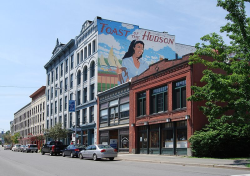 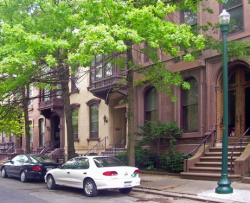 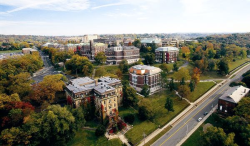
|
Through much of the 19th and into the early 20th century, Troy was not only one of the most prosperous cities in New York State, but one of the most prosperous cities in the entire country. Prior to its rise as an industrial center, Troy was the transshipment point for meat and vegetables from Vermont which were sent by the Hudson River to New York City. The Federal Dam at Troy is the head of the tides in the Hudson River and Hudson River sloops and steamboats plied the river on a regular basis. This trade was vastly increased after the construction of the Erie Canal, with its eastern terminus directly across the Hudson from Troy at Cohoes in 1825. Troy's one-time great wealth was produced in the steel industry, with the first American Bessemer converter erected on the Wyantskill, a stream with a falls in a small valley at the south end of the city. The industry first used charcoal and iron ore from the Adirondacks. Later on, ore and coal from the Midwest was shipped on the Erie Canal to Troy, and there processed before being sent on down the Hudson to New York City. The iron and steel was also used by the extensive federal arsenal across the Hudson at Watervliet, New York, then called West Troy. After the American Civil War, the steel production industry moved west to be closer to raw materials. The presence of iron and steel also made it possible for Troy to be an early site in the development of iron storefronts and steel structural supports in architecture, and there are some significant early examples still in the city. |
The initial emphasis on heavier industry later spawned a wide variety of highly engineered mechanical and scientific equipment. Troy was the home of W. & L. E. Gurley, Co., makers of precision instruments. Gurley's theodolites were used to survey much of the American West after the Civil War and were highly regarded until laser and digital technology eclipsed the telescope and compass technology in the 1970s. Bells manufactured by Troy's Meneely Bell Company ring all over the world. And Troy was also home to a manufacturer of racing shells that used impregnated paper in a process that presaged the later use of fiberglass, Kevlar and carbon fiber composites.
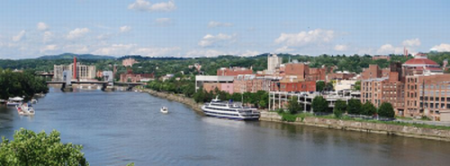
|
This scientific and technical proficiency was supported by the presence of Rensselaer Polytechnic Institute, or RPI, one of the highest-ranked engineering schools in the country. RPI was originally sponsored by Stephen Van Rensselaer, one of the most prominent members of that family. RPI was founded in 1824, and eventually absorbed the campus of the short-lived, liberal arts based Troy University, which closed in 1862 during the Civil War. Rensselaer founded RPI for the "application of science to the common purposes of life", and it is the oldest technological university in the English-speaking world. The institute is known for its success in the transfer of technology from the laboratory to the marketplace. |
|
Parts of this text were copied from 
Conference Venue

|
Rensselaer Polytechnic Institute (RPI) |
How to reach Troy and the Conference Location 
By Plane
|
If you are arriving by plane you fly into Albany International Airport. Commercial taxicabs to campus are available from both the airport and the train station 24/7. The fare is around $30 from both locations. Public transportation is also available. (see below) Please check Google map for detailed information on bus schedules. |
By Train |
By train, travel to the Albany/Rensselaer Amtrak station and from there you can take public transport or a taxi. (see below) |
By Bus and Shuttle |
There are frequent buses between downtown Albany and New York City, operated by: Prices for a one way ticket range between $20 and $30. Greyhound also offers several buses between Albany and Boston and between Albany and Montreal daily.
|
By Taxi |
Commercial taxicabs to campus are available from both the airport and the train station 24/7. The fare is around $30 from both locations. |
By Car
|
Cars can be rented at Albany International Airport.Use Google Maps or the maps below to organize your travel journey. |
Troy Maps
Click on the above maps for a better view
BEWARE

When you bring your PC or other equipment to the USA be aware that different plugs are needed.
- That your VISA requirements are OK. See the Fees Page for more information.

 Troy is a city in the US State of New York and the seat of Rensselaer County. Troy is located on the western edge of Rensselaer County and on the eastern bank of the Hudson River. Troy has close ties to the nearby cities of Albany and Schenectady, forming a region popularly called the Capital District. Historic Troy is in the heart of New York's Industrial Revolution. Downtown Troy mercifully escaped much of the "urban renewal" trend of the mid 20th century, and is thus home to spectacular examples of 19th century Dutch-themed brownstones and storefronts. The downtown area is remarkably compact and lends itself to walking tours. It is conveniently located about three hours from New York City, three hours from Boston and four hours from Montreal.
Troy is a city in the US State of New York and the seat of Rensselaer County. Troy is located on the western edge of Rensselaer County and on the eastern bank of the Hudson River. Troy has close ties to the nearby cities of Albany and Schenectady, forming a region popularly called the Capital District. Historic Troy is in the heart of New York's Industrial Revolution. Downtown Troy mercifully escaped much of the "urban renewal" trend of the mid 20th century, and is thus home to spectacular examples of 19th century Dutch-themed brownstones and storefronts. The downtown area is remarkably compact and lends itself to walking tours. It is conveniently located about three hours from New York City, three hours from Boston and four hours from Montreal.
